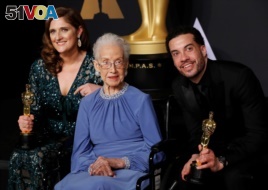28 February 2020
The United States space agency recently marked the loss of a very important person to America's early space efforts.
NASA mathematician Katherine Johnson died earlier this month at the age of 101. She was an African American woman who is credited with breaking race barriers by working in NASA's early space program.
"Our NASA family is sad to learn the news that Katherine Johnson passed away this morning at 101 years old," NASA Administrator Jim Bridenstine wrote on Twitter. "She was an American hero and her pioneering legacy will never be forgotten," he added.
Johnson received the Presidential Medal of Freedom from former President Barack Obama in 2015. At the time, then-NASA Administrator Charles Bolden praised Johnson. He said, "She's one of the greatest minds ever to grace our agency or our country."
A 2016 book called Hidden Figures was based on her life and experiences. It was turned into a Hollywood movie the same year. The film received three Academy Award nominations from the film industry. Johnson attended the Academy Awards ceremony the following year with actors from the film.
What did Johnson do?
Johnson and her colleagues were known as human "computers" during the early years of NASA's efforts to start the space program. They used pencils, slide rules and mechanical calculating machines to calculate the paths of rockets and orbiters in the atmosphere and in space. Johnson worked on the first mission to put an American in space in 1961. She also confirmed the computer calculations made by IBM computers for orbits of the Earth in 1962.

FILE PHOTO: 89th Academy Awards - Oscars Backstage - Hollywood, California, U.S. - 26/02/17 – Presenter Katherine Johnson with Best Feature Documentary winners Ezra Edelman and Caroline Waterlow for O.J: Made in America. REUTERS/Lucas Jackson/File Photo -
Johnson told The Virginian-Pilot newspaper in 2012, "Our office computed all the [rocket] trajectories."
But Johnson and her African American coworkers were little known by the public until the appearance of the book and movie. One reason is because NASA segregated the group at the Langley Research Center in Hampton, Virginia. In other words, government officials kept the women separate because of the color of their skin.
Although she worked in a group separated from white workers, Johnson said that she was too busy to be concerned with racism. Margot Lee Shetterly wrote in her book Hidden Figures that Johnson "didn't close her eyes to the racism that existed." She instead "willed it out of existence inasmuch as her daily life was concerned."
Johnson grew up in West Virginia at a time when education for African Americans was limited. Her mother and father moved 120 miles to live in a town that had a high school for African American children.
Her skill in mathematics got her into West Virginia State College at the age of 15. She also was one of the first black students to enter the graduate school at West Virginia University in 1938.
Later, Johnson went to work for an agency that would become the National Aeronautics and Space Administration, where she worked with other African American women.
She continued with NASA long after the early space flights, working on the Apollo and Space Shuttle programs. She retired in 1986.
She said she was most proud of calculating the paths for the lunar lander and the orbiting command spacecraft for the first trip to the moon, Apollo 11.
Johnson described her abilities to reporters this way: "You tell me when and where you want it to come down, and I will tell you where and when and how to launch it," she said.
I'm Mario Ritter Jr.
Bill Trott reported this story for Reuters. Mario Ritter Jr. adapted it for VOA Learning English. Kelly Jean Kelly was the editor.
_________________________________________________________________
Words in This Story
pioneering –adj. to be among the first to do something usually at great risk
legacy –n. something of value that is passed down from someone who has died
segregated –adj. separated because of some difference such as race or religion
calculate –v. to mathematically arrive at the answer to a problem
trajectory –n. the path that a moving object, like a rocket, takes through the air or space that is governed by the principles of physics
inasmuch –conj. introduces a statement that explains something